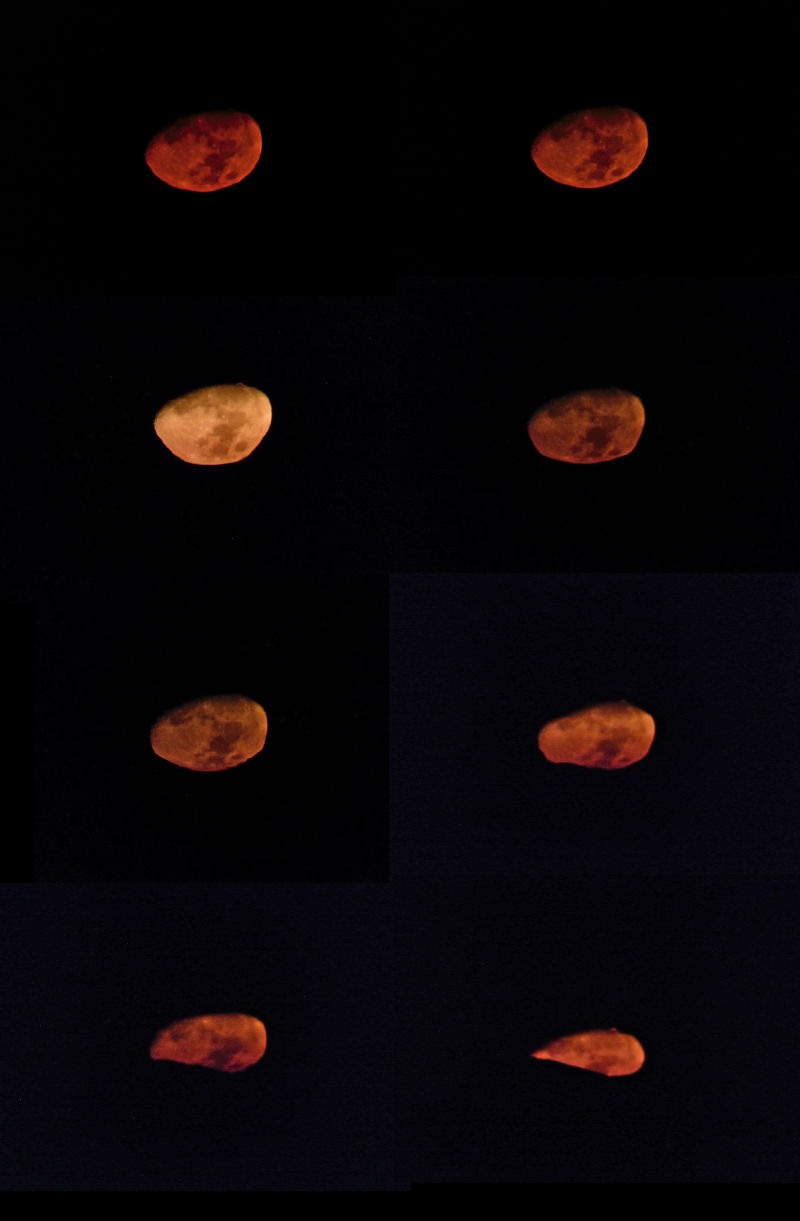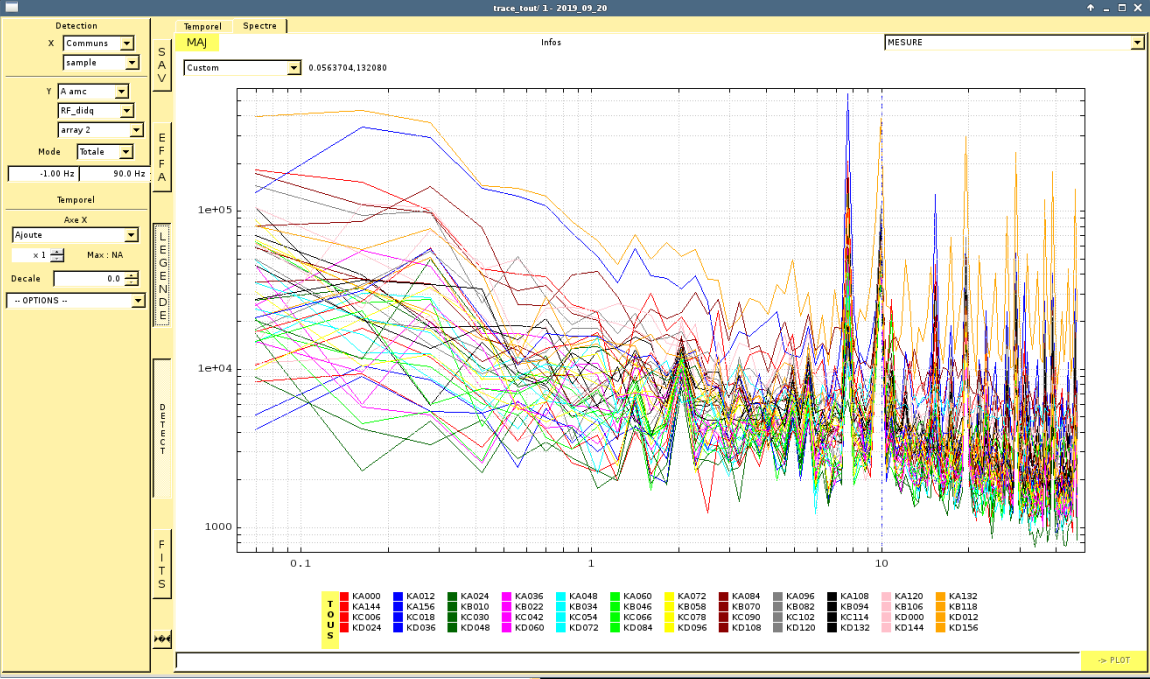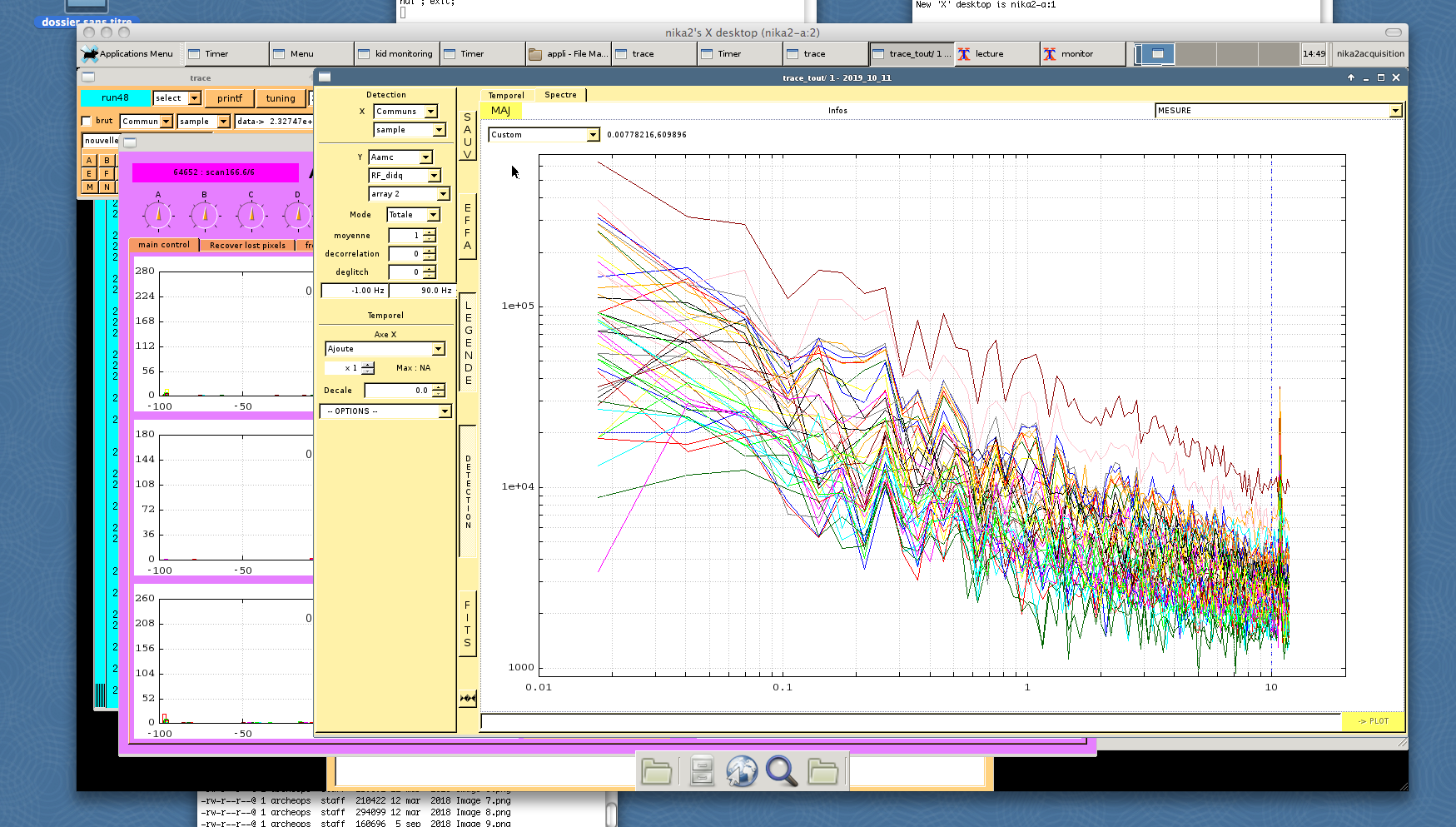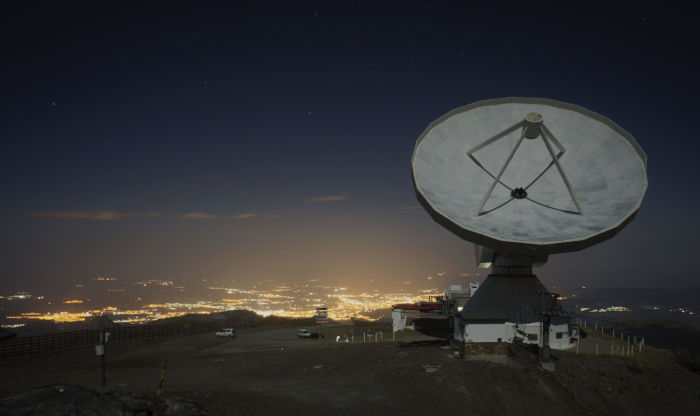Daily Reports
Contents
Oct 7th, Monday
Bilal is at the telescope for preparatory operations.
-- I have a bad feeling about this
Oct 8th, Tuesday
This is the start of the 1st NIKA2 pool of Summer 2019!
Jean-Baptiste, Jean-Paul, Marina, Samantha, and Stefano arrived at the telescope.
And what a start! The instrument is up and running, some problems remains to be identified. We can't start science observation yet because the opacity is above 0.6, but we still take this time to get NIKA2 in prime condition for the weeks to come. The opacity is going down (~0.5), so let's hope for the best tonight!
Night shift (Jean-Baptiste and Stefano + Bilal until ~23 UT)
The sky opacity is above 0.5. We perform some pointing and focus scans and one beam-map for learning standard operations. Then we wait for the sky to get better. Bilal is with us for a while (until ~23 UT). Following the AOD advice, we take some calibration scans after 23 UT, despite the sky opacity is still slightly out of the acceptable range.
A focus sequence taken across midnight UT is affected by the usual "midnight bug". Please check it out again.
At 2 a.m. UT we're still waiting for the opacity to get better, and it actually gets worse... for consolation the moon offers us a never-seen-before show, as she dives into the horizon.
Fotos of the day:
Oct 9th, Wednesday
While the opacity was too bad to observe with NIKA2, Dave continued investigating for the 10Hz spurious noise recently found in the cabin during the afternoon. Nothing was found, and as the evening arrived, we continued working with the instrument.
The opacity slowly drops to 0.5 when arrives the night.
Night shift (Jean-Baptiste and Stefano + Bilal until ~23:30 UT)
"In the cabin", NIKA2 sees the parasite signal, but with these sub-optimal sky conditions the parasite is mostly lost in the sky noise. See the picture below. This tells us that - with these sky conditions (tau>~0.5) the contribution of the parasite to the noise of the data is negligible.
==> Visibly something has changed then, check on September test run; we had similar opacities, and the parasite signal was much more visible in the spectra ! Maybe need to check the absolute value of the spectra level, to be sure whether there's a real change or not. I remember we had spikes at > 105, while here, even below 104 we barely see the spikes... --SL--
==> Yes, you are right, we saw it also with bad weather. Dave touched something around NIKA2 during the day. It might be that indeed something changed. I copy below here one pow-spec image taken during the commissioning week on Sep. 20th --SB--
We proceed with calibrators and tests on extended sources in poor sky conditions (tau>0.5) until 2:25 UT.
Then we observe Planck point-like sources (positioning and flux monitoring):
PCCS2G 156.13
PCCS2G 152.56
PCCS2G 149.61 faint
PCCS2G 141.05
PCCS2G 140.55
PCCS2G 142.61
PCCS2G 142.60
PCCS2G 140.37 NGC0891
PCCS2G 140.13
Oct 10th, Thursday
Night shift (Jean-Baptiste and Stefano + Bilal until 1:45 UT + Samantha until 00:30 UT)
Tonight, the opacity is slowly going under 0.5. We will track as much as possible the project 028-19, if the opacity stays like that.
--Fanfare sounds
23:50PM, UT, We finally start science! The project 028-19 is started with decent conditions (opacity around 0.4). We see emission on each scan, for this very faint dusty region.
We encounter again the midnight bug with scan 274.
At roughly 1:00 UT we start the usual round of calibrators.
After the calibration set and while waiting that B10 comes again below 80 deg elevation, we go on with the monitoring of PCCS sources. The sky conditions have also gotten worse (now tau>~0.5). We observe:
PCCS2G161.84
PCCS2G165.51 faint
PCCS2G174.85
PCCS2G169.15
PCCS2G161.43 faint/extended?
PCCS2G161.62 faint
Oct 11th, Friday
Update about the 10 Hz parasite: in the afternoon, EMIR is in use, because the sky is too cloudy and tau too high for NIKA2. We take the chance to verify the power spectrum of the KIDs instantaneous readout again. This time the KIDs are not watching the sky; they are watching the cabin. The parasite is not there. Evidently yesterday Dave managed to touch the right things! Yeah. According to Bilal who was in the cabin for some time with him, Dave simply touched the NIKA2 electric/net switcheds box, high on the wall at the side of the cryostat and "moved" some NIKA2 cables in that area. Stefano writes an email to Dave to ask for more details. See the pow-spec below.
This afternoon, we tried switching to EMIR, but we encountered a few technical problems. After that, despite the opacity, we tried focusing, but failed as the cloud coverage gets thicker...
Night shift (Jean-Baptiste and Stefano + Bilal until 00:30 UT)
At 21:40 UT we stop observations because the zenith opacity is above unity.
We run a small experiment and confirm that the parasite problem is now solved.
Oct 12th, Saturday
Night shift (Jean-Baptiste and Stefano + Bilal until 1:00 UT)
The weather was bad the whole day.
Today we had visitors:
In the evening the sky improves. It's clear but tau is very high (0.6-0.8). We go on with the monitoring of PCCS2 sources.
For the whole evening a square feature "eating" the upper-left quadrant of the FOV is with us. At scan 20191013s36 - when the weather is finally better and we want to switch to some science - Frederic checks in the cabin and there is a piece of absorber covering part of one mirror. We had put pieces of absorbing material everywhere in the cabin few days ago, trying to isolate the parasite signal, but they have not been put away. Evidently it fell on the mirror earlier today. Now the absorber pieces are not needed anymore, since the parasite problem has been solved (see yesterday's report). They can be removed.
At scan 20191013s38 and 3:07 a.m. UT all is good and we can proceed with a calibration sequence on Uranus, before trying to switch to science (keep finger crossed for a decent opacity).
At 3:30 UT the opacity has worsen again. We complete the calib sequence and it's time to go to bed.
Oct 13th, Sunday
After a long morning with a few science scans on project 028-19, we slowly see the atmosphere become unstable and the opacity variations being faster.
Evening is approaching and the wind is slowly rising.
The storm is here and winds are blowing with spikes around 30m/s...
Oct 14th, Monday
Bad weather.
Night shift (Jean-Baptiste and Stefano + Bilal and Samantha until 3:30 UT)
Around 1 a.m. UT, after rain and clouds, the opacity suddenly drops to ~0.1 and we start observations. We observe: ACT-CL-J0223 (proj 199-16); XLSS072 (proj 093-19);
Oct 15th, Tuesday
Morning shift (Marina)
Go on with good-sky observations (tau 0.12-0.2). We observe projects 028-19, 036-19 and 091-19. And this concludes the first NIKA2 Pool.





